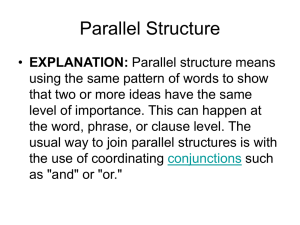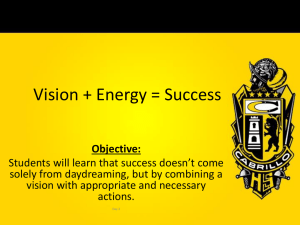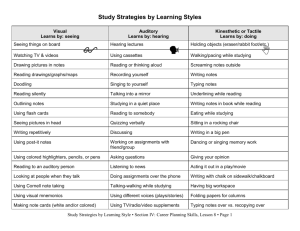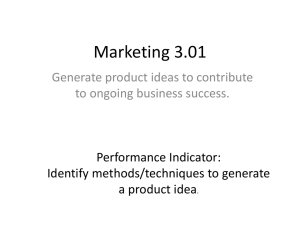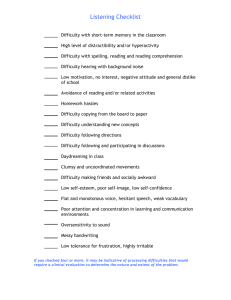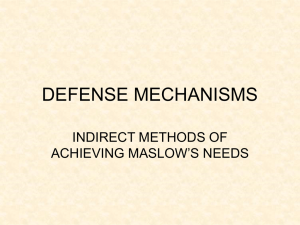What does doodling do?
advertisement
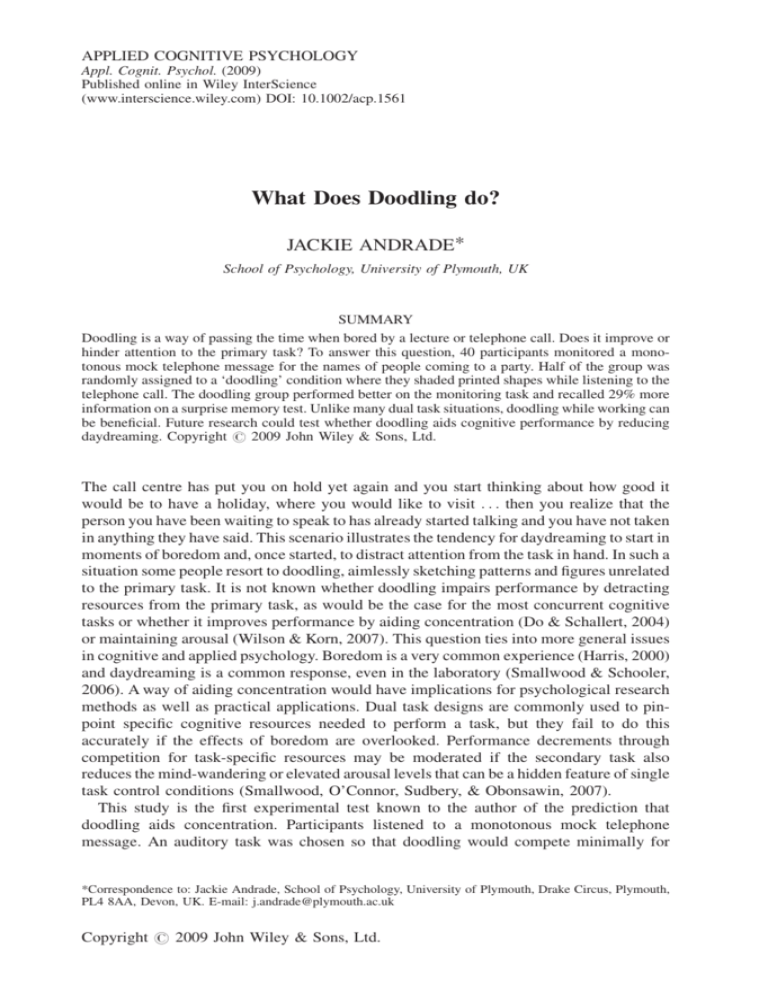
APPLIED COGNITIVE PSYCHOLOGY Appl. Cognit. Psychol. (2009) Published online in Wiley InterScience (www.interscience.wiley.com) DOI: 10.1002/acp.1561 What Does Doodling do? JACKIE ANDRADE* School of Psychology, University of Plymouth, UK SUMMARY Doodling is a way of passing the time when bored by a lecture or telephone call. Does it improve or hinder attention to the primary task? To answer this question, 40 participants monitored a monotonous mock telephone message for the names of people coming to a party. Half of the group was randomly assigned to a ‘doodling’ condition where they shaded printed shapes while listening to the telephone call. The doodling group performed better on the monitoring task and recalled 29% more information on a surprise memory test. Unlike many dual task situations, doodling while working can be beneficial. Future research could test whether doodling aids cognitive performance by reducing daydreaming. Copyright # 2009 John Wiley & Sons, Ltd. The call centre has put you on hold yet again and you start thinking about how good it would be to have a holiday, where you would like to visit . . . then you realize that the person you have been waiting to speak to has already started talking and you have not taken in anything they have said. This scenario illustrates the tendency for daydreaming to start in moments of boredom and, once started, to distract attention from the task in hand. In such a situation some people resort to doodling, aimlessly sketching patterns and figures unrelated to the primary task. It is not known whether doodling impairs performance by detracting resources from the primary task, as would be the case for the most concurrent cognitive tasks or whether it improves performance by aiding concentration (Do & Schallert, 2004) or maintaining arousal (Wilson & Korn, 2007). This question ties into more general issues in cognitive and applied psychology. Boredom is a very common experience (Harris, 2000) and daydreaming is a common response, even in the laboratory (Smallwood & Schooler, 2006). A way of aiding concentration would have implications for psychological research methods as well as practical applications. Dual task designs are commonly used to pinpoint specific cognitive resources needed to perform a task, but they fail to do this accurately if the effects of boredom are overlooked. Performance decrements through competition for task-specific resources may be moderated if the secondary task also reduces the mind-wandering or elevated arousal levels that can be a hidden feature of single task control conditions (Smallwood, O’Connor, Sudbery, & Obonsawin, 2007). This study is the first experimental test known to the author of the prediction that doodling aids concentration. Participants listened to a monotonous mock telephone message. An auditory task was chosen so that doodling would compete minimally for *Correspondence to: Jackie Andrade, School of Psychology, University of Plymouth, Drake Circus, Plymouth, PL4 8AA, Devon, UK. E-mail: j.andrade@plymouth.ac.uk Copyright # 2009 John Wiley & Sons, Ltd. J. Andrade modality-specific resources. Participants monitored the message for specific, infrequent information and afterwards attempted a surprise recall test for that information and for incidental information. Performance was measured in terms of monitoring accuracy and memory, which was assumed to reflect the depth of processing of the monitored material. Rather than being asked to doodle freely, participants were asked to shade in printed shapes on the response sheet, without worrying about the speed and the neatness of their shading. The hope was that the simplicity of this shading task would encourage a degree of absentmindedness in participants’ drawing, akin to that seen in doodling in naturalistic conditions. Participants were not asked to doodle freely in case they felt self-conscious about their drawings or suspected that the content of their doodles was the real focus of the study. In this case their doodling would not have the spontaneous, automatic quality of naturalistic doodling. METHOD Participants and design Participants were 40 members of the MRC Applied Psychology Unit (now the Cognition and Brain Sciences Unit) participant panel, recruited from the general population and aged between 18 and 55 years. They were paid a small honorarium for taking part. Participants were randomly assigned to the control (N ¼ 20; 2 male) or doodling group (N ¼ 20; 3 male). All participants monitored a telephone message and then attempted to recall monitored and incidental information. Recall order was counterbalanced across participants. Materials A mock telephone message was recorded onto audio cassette tape in a fairly monotone voice at an average speaking rate of 227 words per minute, and played at a comfortable listening volume. The script included eight names of people attending a party, and names of three people and one cat who could not attend (see the Appendix). Eight place names were mentioned, along with much irrelevant material. Participants in the doodling condition used a pencil to shade shapes of approximately 1 cm diameter printed on a piece of A4 paper, with 10 shapes per row and alternating rows of squares and circles. A 4.5 cm wide margin on the left-hand side allowed space for writing the target information. Control participants wrote the target information on a lined piece of paper. Procedure Participants were recruited just after finishing an unrelated experiment (on ways of giving directions to different locations) for another researcher, and asked if they would mind spending another 5 minutes helping with research. The intention was to enhance the boredom of the task by testing people who were already thinking about going home. Participants were tested individually in a quiet and visually dull room. They were told: ‘‘I am going to play you a tape. I want you to pretend that the speaker is a friend who has telephoned you to invite you to a party. The tape is rather dull but that’s okay because I don’t want you to remember any of it. Just write down the names of people who will Copyright # 2009 John Wiley & Sons, Ltd. Appl. Cognit. Psychol. (2009) DOI: 10.1002/acp What does doodling do? definitely or probably be coming to the party (excluding yourself). Ignore the names of those who can’t come. Do not write anything else.’’ Participants in the doodling condition were also asked to shade in the squares and circles while listening to the tape. They were told ‘It doesn’t matter how neatly or how quickly you do this—it is just something to help relieve the boredom’. Participants listened to the tape, which lasted 2.5 minutes, and wrote down the names as instructed. When the tape finished, the experimenter collected the response sheets, and engaged participants in conversation for 1 minute including an apology for misleading them about the memory test. Half the participants were then asked to recall the names of party-goers and, when they had done that, of the places mentioned. The other half recalled the places first, followed by the names. During debriefing, participants were asked if they had suspected a memory test. RESULTS Participants in the doodling group shaded a mean of 36.3 of the printed shapes on their response sheet (range 3–110). One participant did not doodle and was replaced. Participants in the control condition did not doodle. Three doodlers and four controls suspected a memory test. None said they actively tried to remember information. Control participants correctly wrote down a mean of 7.1 (SD ¼ 1.1) of the eight names of party-goers during the tape; five people made a false alarm. Doodling participants correctly wrote a mean of 7.8 (SD ¼ 0.4) names of party-goers; one person made one false alarm. Plausible mis-hearings, such as ‘Greg’ for ‘Craig’, were scored as correct. Other new names were scored as false alarms, including names mentioned on the tape as lures. Responses such as ‘sister’ were ignored. For analysis, monitoring performance was scored as the number of correct names minus false alarms. Non-parametric analysis was used because scores were not normally distributed: fifteen doodlers and nine controls scored the maximum of eight. Monitoring performance in the doodling condition (mean ¼ 7.7, SD ¼ 0.6) was significantly higher than in the control condition (mean ¼ 6.9, SD ¼ 1.3), Mann–Whitney U ¼ 124, p ¼ 0.01 one-tailed. Recall performance was scored separately for names and places, using the definitions of correct responses and false alarms above, with the addition that plausible mis-hearings had to be the same in the monitoring and recall phases (see Table 1). Overall, participants in the doodling condition recalled a mean of 7.5 pieces of information (names and places), 29% Table 1. Mean correct recall, false alarms and memory scores (correct minus false alarms) for names and places for the control and doodling groups (standard deviation) Group Control Names (monitored information) Places (incidental information) Copyright # 2009 John Wiley & Sons, Ltd. Correct False alarms Memory score Correct False alarms Memory score 4.3 0.4 4.0 2.1 0.3 1.8 (1.3) (0.5) (1.5) (0.9) (0.6) (1.2) Doodling 5.3 0.3 5.1 2.6 0.3 2.4 (1.4) (0.4) (1.7) (1.4) (0.4) (1.5) Appl. Cognit. Psychol. (2009) DOI: 10.1002/acp J. Andrade more than the mean of 5.8 recalled by the control group. Memory scores were entered into a 2 (doodling, control) 2 (names, places) mixed measures ANOVA which confirmed that the monitored names were recalled better than the incidental places, F(1,38) ¼ 54.9, p < 0.001. Recall was better for doodlers than controls, F(1,38) ¼ 6.0, p ¼ 0.02, for both monitored and for incidental information (interaction F < 1). Removing data from participants who had suspected a test did not alter the pattern of results (main effect of group: F(1, 31) ¼ 6.9, p ¼ 0.01). Entering monitoring performance as a covariate made the group effect marginally significant, F(1,37) ¼ 3.8, p ¼ 0.058. DISCUSSION Participants who performed a shape-shading task, intended as an analogue of naturalistic doodling, concentrated better on a mock telephone message than participants who listened to the message with no concurrent task. This benefit was seen for monitoring performance and in scores on a surprise memory test. When monitoring performance was used as a covariate, the group effect became marginally significant, so it is not clear whether doodling led to better recall simply because doodlers noticed more of the target names or whether it aided memory directly by encouraging deeper processing of the material on the tape. Two methodological features may have contributed to the beneficial effect of doodling by making the primary task seem particularly boring. Participants were recruited and tested immediately after they had finished a colleague’s experiment. The intention was to test people when they were more prone to boredom than if they had just arrived at the laboratory, although we have no evidence that this was the case. Everyone was told that the tape would be dull, to discourage them from searching for something interesting in the material. The doodling task was described as ‘just something to relieve the boredom’, to encourage participants to do it in a fairly naturalistic, automatic fashion. The instructions contained no suggestion that it would improve cognitive performance. It remains to be discovered whether the benefits of the shading task extend to naturalistic doodling. What mechanism might underlie the effect of doodling on concentration? One possibility is that doodling simply helps to stabilize arousal at an optimal level, keeping people awake or reducing the high levels of autonomic arousal often associated with boredom (London, Schubert, & Washburn, 1972). Future research using psychophysiological measures might pick up such effects. A more specific hypothesis is that doodling aids concentration by reducing daydreaming, in situations where daydreaming might be more detrimental to performance than doodling itself. Daydreaming is linked with the generally high arousal levels seen during boredom, through increased activity in ‘default’ cortical networks (Mason, Norton, Van Horn, Wegner, Grafton, & Macrae, 2007; Smallwood et al., 2007b). It occupies central executive resources (Smallwood & Schooler, 2006; Teasdale, Proctor, Lloyd, & Baddeley, 1993) and is detrimental to performance on tasks that compete for those resources (Seibert & Ellis, 1991; Smallwood, Baracaia, Lowe, & Obonsawin, 2003; Smallwood, Fishman, & Schooler, 2007). The message-monitoring task would have encouraged daydreaming because the resource demand of the basic task was low and the task did not explicitly require retention of stimuli (see Smallwood et al., 2007a). Because participants were not told about the forthcoming memory test, they had little incentive to ‘catch’ themselves daydreaming and return their attention to the task. However, performance on the memory test would have Copyright # 2009 John Wiley & Sons, Ltd. Appl. Cognit. Psychol. (2009) DOI: 10.1002/acp What does doodling do? benefited from deeper processing of the stimuli and greater time-on-task, i.e. less daydreaming. Doodling may have facilitated this deeper processing by reducing daydreaming, without competing for the verbal processing resources needed for listening to the telephone message. Doodling may have reduced daydreaming simply by adding a resource load to a rather undemanding task (Smallwood et al., 2007a), in which case increasing the demands of the primary task (requiring speeded responses, for instance) would have had a similar effect. Alternatively, doodling may have reduced daydreaming by selectively loading central executive resources. Although doodling is itself relatively undemanding of executive resources, being self-paced, repetitive and involving little controlled processing such as performance monitoring or inhibition of irrelevant information, the combination of doodling with the auditory message-monitoring task should have engaged executive resources needed to coordinate verbal and visuo-spatial short-term memory (Baddeley, 1996). It is hypothesized that this continual but small central executive load detracted minimally from the primary auditory task yet was sufficient to prevent the greater impairment to performance that would have occurred if central executive resources were free for daydreaming. A limitation of the present study is that it lacks any measure of daydreaming. A replication that included thought probes (e.g. Teasdale et al., 1993) during the telephone message, or retrospective self-report of daydreaming, would test whether the effect of doodling on memory occurred via effects on daydreaming. Future neuroimaging studies could test the hypothesis that doodling selectively reduces cortical activation associated with daydreaming. The present finding that doodling aids concentration, and explaining the potential mechanism for this, has important implications. The extent to which secondary tasks have beneficial effects or fail to have predicted detrimental effects is a ‘file drawer problem’, though a recent paper by Roche et al. (2007) reports unexpected benefits of secondary tasks on visuomotor learning that were not due to increased arousal. Understanding the role of boredom and daydreaming, and tasks that alleviate them, would allow a more complete cognitive analysis of task performance in the laboratory and in real-life work and educational settings (Smallwood & Schooler, 2006; Smallwood et al., 2007a). Ways of maintaining attention to task are also important in the context of depressive ruminations and worry, where mind wandering helps maintain dysphoric states (Smallwood et al., 2007b). ACKNOWLEDGEMENTS The author thanks Tim Perfect, Michael Verde, Jon May, Samantha Webber, Hayley Penton and Jonathan Smallwood for their comments. REFERENCES Antrobus, J. S. (1968). Information theory and stimulus-independent thought. British Journal of Psychology, 59, 423–430. Baddeley, A. D. (1996). Exploring the central executive. Quarterly Journal of Experimental Psychology, 49A, 5–28. Do, S. L., & Schallert, D. L. (2004). Emotions and classroom talk: Toward a model of the role of affect in students’ experiences of classroom discussions. Journal of Educational Psychology, 96, 619–634. Copyright # 2009 John Wiley & Sons, Ltd. Appl. Cognit. Psychol. (2009) DOI: 10.1002/acp J. Andrade Harris, M. B. (2000). Correlates and characteristics of boredom proneness and boredom. Journal of Applied Social Psychology, 30, 576–598. London, H., Schubert, D. S. P., & Washburn, D. (1972). Increase of autonomic arousal by boredom. Journal of Abnormal Psychology, 80, 29–36. Mason, M. F., Norton, M. I., Van Horn, J. D., Wegner, D. M., Grafton, S. T., & Macrae, C. N. (2007). Wandering minds: The default network and stimulus-independent thought. Science, 315, 393–395. Roche, R. A. P., Commins, S., & Agnew, F., et al. (2007). Concurrent task performance enhances lowlevel visuomotor learning. Perception & Psychophysics, 69, 513–522. Seibert, P. S., & Ellis, H. C. (1991). Irrelevant thoughts, emotional mood states and cognitive performance. Memory and Cognition, 5, 507–513. Smallwood, J. S., & Schooler, J. W. (2006). The restless mind. Psychological Bulletin, 132, 946–958. Smallwood, J., Baracaia, S. F., Lowe, M., & Obonsawin, M. C. (2003). Task unrelated thought whilst encoding information. Consciousness and Cognition, 12, 452–484. Smallwood, J., Fishman, D. J., & Schooler, J. W. (2007). Counting the cost of an absent mind: Mind wandering as an underrecognized influence on educational performance. Psychonomic Bulletin & Review, 14, 230–236. Smallwood, J., O’Connor, R. C., Sudbery, M. V., & Obonsawin, M. (2007). Mind-wandering and dysphoria. Cognition and Emotion, 21, 816–842. Teasdale, J. D., Proctor, L., Lloyd, C. A., & Baddeley, A. D. (1993). Working memory and stimulusindependent thought: Effects of memory load and presentation rate. European Journal of Cognitive Psychology, 5, 417–433. Wilson, K., & Korn, J. H. (2007). Attention during lectures: Beyond ten minutes. Teaching of Psychology, 34, 85–89. APPENDIX The boring telephone message: monitored names are shown in bold, incidental places in italics. ‘‘Hi! Are you doing anything on Saturday? I’m having a birthday party and was hoping you could come. It’s not actually my birthday, it’s my sister Jane’s. She’ll be 21. She’s coming up from London for the weekend and I thought it would be a nice surprise for her. I’ve also invited her boyfriend William and one of her old schoolfriends, Claire, but she doesn’t know that yet. Claire’s husband Nigel was going to join us but he has just found out that he has to go to a meeting in Penzance that day and won’t be back in time. I thought we could have a barbecue if the weather is nice, although the way it has been so far this week, that doesn’t look likely. I can’t believe it has got so cold already. And the evenings are really drawing in aren’t they? Anyway, there is plenty of space indoors if it rains. Did I tell you that I have redecorated the kitchen? It is mainly yellow—the wallpaper is yellow and so is the woodwork, although I thought it would be better to leave the ceiling white to make it look lighter. I’ve still got the old blue fittings—they are pretty battered now but I can’t afford to replace them at the moment. Do you remember Craig? I used to share a flat with him when we were both working for that bank in Gloucester. He has bought a house in Colchester now but he promises to take time off from gardening to come to Jane’s party. Suzie is going to be there too. She’s the person I met at the pottery class in Harlow last year. Apparently she has got really good at it and may even be having an exhibition of her work soon. Will you be able to bring some food? Maybe crisps or peanuts, something along those lines. Jenny from next door is going to bring a quiche and I’ll do some garlic bread. I found a good recipe for punch—you warm up some red wine with gin and orange juice plus cloves and cardomom and cinnamon. Add some brown sugar if it’s not sweet enough. The boys Copyright # 2009 John Wiley & Sons, Ltd. Appl. Cognit. Psychol. (2009) DOI: 10.1002/acp What does doodling do? from the house down the road have promised to bring some of their homebrew. There are three of them sharing that house now—John, Tony and Phil. I think they were all at college together. Phil teaches at a primary school in Ely now and the other two commute to Peterborough each day. I think they both work in the hospital there—I know Tony was training to be a nurse at one point so maybe he is qualified now. John can’t come on Saturday because his parents are coming to stay for the weekend but Phil and Tony should be there. Tony has to pick their cat Ben up from the vet so he may be a bit late. By the way, did I tell you about our holiday in Edinburgh? It was a complete disaster. We were camping and it rained constantly. We spent most of the time in museums, trying to keep dry and then, to make matters worse, Nicky got her handbag stolen. I was quite glad to get back to work after that. Anyway, hope you can make it on Saturday—let me know if you want to stay over. Bye!’’ Copyright # 2009 John Wiley & Sons, Ltd. Appl. Cognit. Psychol. (2009) DOI: 10.1002/acp



